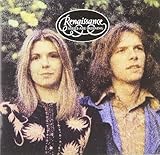Ashes Are Burning
By Renaissance
Capitol Records, 1972
Review by Carl McColman
 Once upon a time (when Ronald Reagan was merely an ex-governor from California and "liberal" was not a dirty word), back before the 80s marketing gurus dreamed up the term "classic rock" to describe anything that predated the Sex Pistols, there was a genre of popular music known as "classicAL rock," which it signified music that blended classical motifs and themes with the basic structure of rock'n'roll. Several bands were known for this genre, including Yes, Emerson Lake & Palmer, Genesis (when Peter Gabriel was still a member) and Renaissance — musicians who either borrowed from, or were inspired by, classical repertoire in order to give their work a more expansive feel. Today this genre is mostly called "prog-rock" ("progressive rock"), but "classical rock" remains the more accurate term. Of these acts, Renaissance may not have had multi-platinum-level commercial success, but created arguably the most beautiful and "pure" form of classical rock. At times playfully lifting themes from the works of composers like Rachmaninov, Debussy, Rimsky-Korsakov, and Faure, Renaissance created a sound that was majestic, big, fully rock'n'roll, and anchored by John Tout's aggressive piano playing and Annie Haslam's operatic soprano. And while classical rock was never hip enough for the critics who wrote for magazines like Rolling Stone, to those of us who heard beauty in this music, it was (and still is) transcendent and glorious, a testament to humankind's desire to reach for something greater — greater beauty, greater happiness, greater understanding.
Once upon a time (when Ronald Reagan was merely an ex-governor from California and "liberal" was not a dirty word), back before the 80s marketing gurus dreamed up the term "classic rock" to describe anything that predated the Sex Pistols, there was a genre of popular music known as "classicAL rock," which it signified music that blended classical motifs and themes with the basic structure of rock'n'roll. Several bands were known for this genre, including Yes, Emerson Lake & Palmer, Genesis (when Peter Gabriel was still a member) and Renaissance — musicians who either borrowed from, or were inspired by, classical repertoire in order to give their work a more expansive feel. Today this genre is mostly called "prog-rock" ("progressive rock"), but "classical rock" remains the more accurate term. Of these acts, Renaissance may not have had multi-platinum-level commercial success, but created arguably the most beautiful and "pure" form of classical rock. At times playfully lifting themes from the works of composers like Rachmaninov, Debussy, Rimsky-Korsakov, and Faure, Renaissance created a sound that was majestic, big, fully rock'n'roll, and anchored by John Tout's aggressive piano playing and Annie Haslam's operatic soprano. And while classical rock was never hip enough for the critics who wrote for magazines like Rolling Stone, to those of us who heard beauty in this music, it was (and still is) transcendent and glorious, a testament to humankind's desire to reach for something greater — greater beauty, greater happiness, greater understanding. Ashes Are Burning was Renaissance's fourth album, but their second featuring their classic lineup of Annie Haslam, John Tout, Jon Camp, and Terence Sullivan (although not credited as a band member, Michael Dunford wrote nearly all the music, and later did take his place as the fifth member of the group). The album's first track, "Can You Understand?" opens with an understated gong which gives way to a piano torrent exploding into an assertive rock jam, an energetic celebration of Renaissance's signature sound. But the music slows down, and accompanied by a twelve-string guitar, Annie's voice soars into the song. With dreamy, impressionistic lyrics, "Can You Understand?" asks the listener to cultivate mindfulness — a theme which appears again and again on this album. As the song portion of this majestic composition progresses, Annie and the band are joined by a full orchestra, adding still more color to the already richly textured sound. Eventually the music erupts into another fit of energetic rocking. Haslam's voice and lyricist Betty Thatcher's otherworldly images might be delicate, but this band has muscles and isn't afraid to flex them.
"Let it Grow" and "On the Frontier" are more subdued showcases for the band's lovely vocals ("On the Frontier" shows that the guys can harmonize beautifully with Haslam), but the true majesty of this recording begins with the fourth track (the first song of side two back in the days of vinyl). "Carpet of the Sun," a light-hearted celebration of nature and light, is probably the closest Renaissance ever came to having a hit single; it is a song that still finds its way onto 70s anthologies, and with good reason. Acoustic guitar, orchestration, and piano weave together in a light, joyful melody, and Annie Haslam's interpretation of the song's sunny lyrics find her voice at its songbird best. It's one of the happiest pieces of music ever to grace a rock album. "Smells Like Teen Spirit" this isn't. It's optimistic, joyful, and deeply spiritual—a perfect antidote to the cynicism of our time.
Lest Renaissance seem pollyannish in the face of all this happy music, "At the Harbour" evokes a darker feeling of loss and grief—all is not sweetness and light in Renaissance's world. A somber song about women waiting for a boat that was lost at sea, it is the dark counterpoint to "Carpet of the Sun." But if these two songs function as some sort of Hegelian thesis/antithesis, the grand synthesis comes in the album's final opus, the 11-and-a-half minute title track. Beginning with a haunting sound of cymbals almost overwhelmed by the whistling of a stormy wind, an introspective mid-tempo piano melody (accompanied by a pulsating bass line) introduces the music. Haslam's voice, sounding pensive and perhaps even wistful, adds to the mood of the lyrics, which explore themes of vision, the taking of a journey, and (again) the need for clarity of mind. Like the central image of burning ashes, the song has a melancholy feel, evoking a sense of loss and regret that seems an inevitable part of the march of time. But this mood suddenly changes when the tempo picks up, the lyrics give way to a graceful passage of vocalise, and the music blossoms like an opening flower into an extended, tuneful jam. Each of the musicians shows off his virtuosity, culminating in a moment of deep stillness, when (accompanied only by an organ), Haslam sings the final verse, a stunning resolution of the song's yearning in a mystical affirmation of forgiveness and love. "Imagine the burning embers, the glow below and above, your sins you won't remember, and all you'll find there is love." What is this referring to? The flames of purgatory? The fires of divine love? Haslam never says. We are left to interpret the words for ourselves: Out of loss comes redemption, out of the passage of time comes the doorway to eternity. Once more, the music explodes into a lovely coda. It's a stunning climax, but as it slowly fades away the message is simple: nothing really ends, it only changes.
Ashes Are Burning is a salutory example of how popular culture can convey the emotional resonance of mystical yearning. Maybe in today's world of rave music and technopop it might seem a little outdated, but on another level it's as timeless as the classical music that inspired this artful band. Beauty, after all, never goes out of style. And if one word could describe the music contained herein, "beautiful" would be the word.


0 Comments:
Post a Comment
<< Home